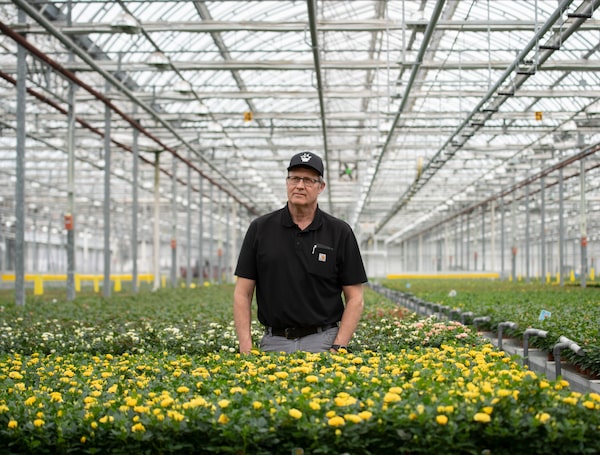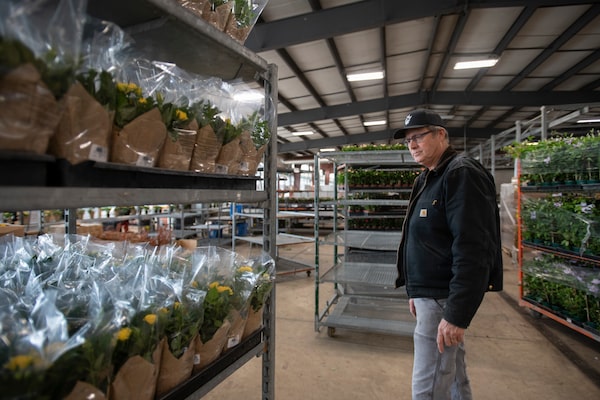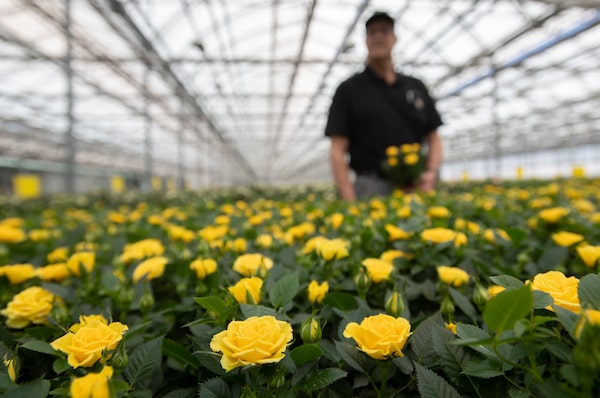
Len Vander Lugt, president and owner of Aldershot Greenhouses Ltd., is photographed amongst some of the Cho roses the company grows, on May 13, 2020.Fred Lum/The Globe and Mail
Len Vander Lugt will never forget March 15. One after another, customers cancelled orders for thousands upon thousands of miniature roses. Employees, anxious over the spread of the novel coronavirus, began to grow frightened about coming to work.
“That was the day panic over the coronavirus started to set in,” says Mr. Vander Lugt, the president and owner of Aldershot Greenhouses Ltd., a family-run business in Southern Ontario. “It was complete chaos.
“We had fought to keep a business going for 65 years, and suddenly I was fighting a battle on two different fronts. My staff was looking at me like I was trying to kill them, and I was worried because we had flowers we were trying to keep alive.”
Opened in 1954 to cultivate chrysanthemums, Aldershot has become one of the largest growers of potted mini roses in North America. On average, its greenhouses in Burlington and Waterdown, near Hamilton, produce 80,000 plants each week.
Around Easter and Mother’s Day, the figure increases by four times.
The COVID-19 pandemic has wreaked havoc on Mr. Vander Lugt and Canada’s other growers of ornamental flowers, most of which are in Ontario. As the disease spread, florists and garden centres shut down. Funerals and weddings were curtailed. Grocery stores commercial growers rely upon for a majority of sales stopped buying flowers and focused on toilet paper and other products.
“Everyone was shopping as if they were a member of SEAL Team Six,” Mr. Vander Lugt says. “They would get in and out of a store with their produce, bread and milk as quickly as they could. Nobody was looking at roses.”
Mr. Vander Lugt estimates that over two months, Aldershot Greenhouses tossed $1-million worth of its signature roses onto a compost pile. In a discussion with a local councillor, he explained the scale of the disaster.
“I told him I had one rose for every person that lives in Hamilton,’” Mr. Vander Lugt says. “I had 500,000 roses. I hated to see them dumped, but it didn’t make sense to keep them any more.”
According to Statistics Canada, sales of cut flowers, potted plants, nursery items, Christmas trees and sod amounted to a combined $2.34-billion in 2018. Of that, $1.56-billion came from items grown in greenhouses.
More than half of the nationwide sales from floriculture and greenhouses are generated by Ontario’s 180 producers.
Like Mr. Vander Lugt, many make 60 per cent of their annual revenue between Easter and Mother’s Day.
“There are many businesses that base their entire year around Easter, and they are going to be feeling a pinch,” says Andrew Morse, executive director of Flowers Canada Ontario. "It is a shame. At the beginning of the year, their numbers were tracking ahead of last year.
“We hope to find ways to help them recover lost sales, but some won’t be able to do it.”

Like Mr. Vander Lugt, seen here, many greenhouses make 60 per cent of their annual revenue between Easter and Mother’s Day.Fred Lum/The Globe and Mail
Mr. Morse says he began to receive calls from panicked ornamental growers between March 12 and March 15 as massive orders were suddenly cancelled.
“They wanted to know if I thought things were going to get better or worse, but it was very hard to say,” he says.
Some of the farmers that specialize in annuals, biennials, perennials and other fast-growing bedding plants scaled back production.
“Now they are finding they could have sold them,” Mr. Morse says. “It has really become a guessing game.”
Mr. Morse said ornamental producers have access to traditional agricultural financial aid designed to cover large declines in net income, but not most programs related to COVID-19.
“A lot of them do not target greenhouses or fit seasonal businesses,” he says.
Keith Currie, the vice-president of the Canadian Federation of Agriculture, says farming drives about one-third of the Canadian economy, and that agriculture supports 840,000 jobs.
“It is a big industry and everybody has been affected [by the novel coronavirus] in one shape or form,” says Mr. Currie, who grows gladiolas and sweet corn in Collingwood, Ont.
He says most farms are family owned, and that farmers often have minimal earnings or none, so their income is hard to quantify. For example, he says, they receive shares in the business in lieu of wages, which makes it more challenging to qualify for government aid.
“When it comes to business benefits, we often fall through the cracks,” Mr. Currie says. “We need easy risk-management programs to be in place. There is no safety net for us.”
Andy Kuyvenhoven’s grandfather grew chrysanthemums in the Netherlands. His father immigrated to Canada, bought a greenhouse in Southern Ontario and put Andy to work in it when he was nine years old.
A half-century later, he is still at it, operating Kuyvenhoven Greenhouses in Brampton and Halton Hills with the help of his wife, Mary, and sons, Peter and Michael.
In most years, about 60 per cent of his annual sales come between Easter and the middle of June. But this year, garden centres and flower shops were closed from the end of March until nearly Mother’s Day.
“I’ve likened it to retailers being told to close over the two weeks prior to Christmas and to throw out half of their inventory,” says Mr. Kuyvenhoven, past-president of Flowers Canada Ontario.
He did only about half as much business as usual for Mother’s Day. He gave as many potted mums and calla lilies as he could to churches, health care workers and seniors. The rest he composted. He estimates the loss at $250,000.
“When our product is ready, it’s ready,” Mr. Kuyvenhoven says. “It’s live produce. To give it away or throw it out is both mentally and physically difficult."
Ian Vermeer, the vice-president of Westbrook Floral, says he threw out thousands of the roses and African violets he grows in Beamsville, Ont.
“There were points where we weren’t selling things,” says Mr. Vermeer, a member of the Ontario Greenhouse Alliance. “Most growers had a tremendous amount of waste. It’s devastating. We play with a very thin margin."
Ontario relaxed its restrictions last week, allowing garden centres to open for pickup and with physical distancing.
“It is a tremendous weight off our shoulders,” Mr. Vermeer says. “Now it is up to people to decide if they feel comfortable enough to go out and shop. We are optimistic.”
Len Vander Lugt says the only time he has ever seen sales plummet this badly was after the terrorist attacks of Sept. 11, 2001.
“The difference is that in that case there was a conclusion to it and a point when people’s lives began to return to normal," he says. “This just runs on and on.”
He employs more than 100 workers, and says that although Easter was a disaster, he did reasonable business for Mother’s Day.
Last week, he took a few days off to recuperate from the stress.
“The last two months were terrible, actually,” he says. “I don’t ever want to do that again.”

Fred Lum/The Globe and Mail